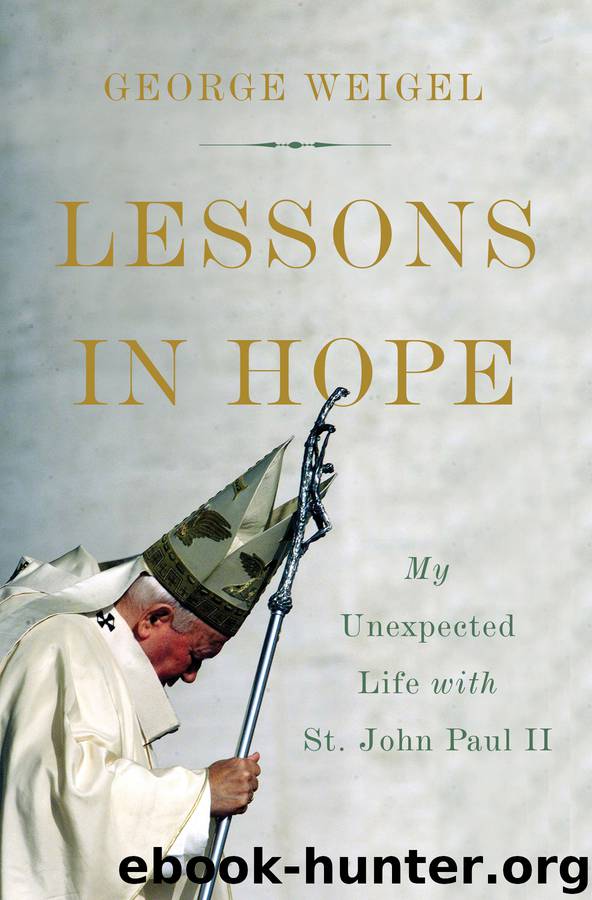Lessons in Hope by George Weigel

Author:George Weigel
Language: eng
Format: epub
Tags: Biography & Autobiography / Religious, Religion / Christianity / Catholic, Biography & Autobiography / Personal Memoirs, Religion / Christian Church / Leadership, Religion / Christian Church / History
Publisher: Basic Books
Published: 2017-09-19T04:00:00+00:00
LITERARY ARCHITECTURE
CHARLESTON, SEPTEMBER 1997
ON MY RETURN FROM PARIS IN AUGUST 1997 I CALLED MY FRIEND Father Jay Scott Newman at Divine Redeemer Catholic Church in Hanahan, South Carolina, near Charleston: might I stay with him for a week while I decided how to structure Witness to Hope? The amount of material I had gathered was threatening to become overwhelming, so it seemed the right time, and Fr. Newman’s rectory the right place, to erect a framework on which the book could be built. Ever the gracious Southern gentleman, Fr. Newman replied that his guest room was at my disposal for as long as I liked.
The biggest structural problem in designing Witness to Hope was to figure out how to insert discussions of Karol Wojtyła’s thought and John Paul II’s magisterium into the narrative without bogging down the story. When I finished wrestling with this problem at Fr. Newman’s, I had an outline of some 125 pages, into which I inserted references—to books, articles, or interview notes—so that when it came to writing, I wasn’t juggling masses of paper trying to find what I was looking for.
Books in progress are like children: a book has a kind of mind of its own, and it will push back against an author. No matter how well planned, at some point or another the book is going to want to go that way and the author is going to say, “No, we’re going this way.” There was one such tug of war when it came to writing Witness to Hope, involving where to insert a discussion of Wojtyła’s philosophical work. Other than that, the long outline I completed during that week in South Carolina stood me in good stead over the next year of intense writing.
Mother Teresa of Calcutta died a week before I got to Hanahan, and the Princess of Wales died five days after the foundress of the Missionaries of Charity. As Fr. Newman and I watched the evening news, we couldn’t help but notice the sharp contrast between how the world was reacting to the deaths of these two widely admired women, icons of different facets of the late twentieth century. Mother Teresa’s death was generally handled as it should have been, even by secular people skeptical about consecrated religious life: here was a saint, whether you believed in sanctity in the Catholic Church’s terms (heroic virtue made possible by grace) or the world’s terms (manifest decency and compassion). The contrast with the British reaction to Diana’s death was shattering. As I said to Fr. Newman when we were watching one TV news report of the semihysterical crowds outside Buckingham Palace, it wasn’t a pretty picture to see “an entire country having a nervous breakdown.” What on earth was going on? The subject would shortly recur at the papal board.
Download
This site does not store any files on its server. We only index and link to content provided by other sites. Please contact the content providers to delete copyright contents if any and email us, we'll remove relevant links or contents immediately.
Resisting Happiness by Matthew Kelly(3201)
The Social Psychology of Inequality by Unknown(2774)
Designing Your Life by Bill Burnett(2606)
Day by Elie Wiesel(2599)
The Giving Tree by Shel Silverstein(2178)
Angels of God: The Bible, the Church and the Heavenly Hosts by Mike Aquilina(1871)
Human Design by Chetan Parkyn(1860)
The Supreme Gift by Paulo Coelho(1802)
Jesus of Nazareth by Joseph Ratzinger(1710)
Augustine: Conversions to Confessions by Robin Lane Fox(1689)
Hostage to the Devil by Malachi Martin(1677)
7 Secrets of Divine Mercy by Vinny Flynn(1623)
Dark Mysteries of the Vatican by H. Paul Jeffers(1607)
The Vatican Pimpernel by Brian Fleming(1589)
St. Thomas Aquinas by G. K. Chesterton(1559)
Saints & Angels by Doreen Virtue(1532)
The Ratline by Philippe Sands(1426)
My Daily Catholic Bible, NABRE by Thigpen Edited by Dr. Paul(1419)
Called to Life by Jacques Philippe(1411)
